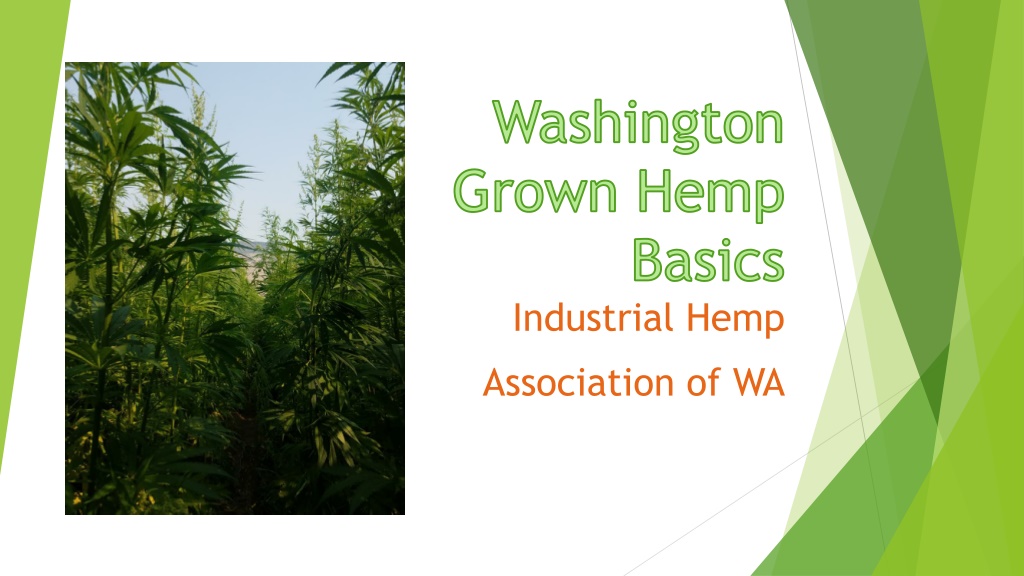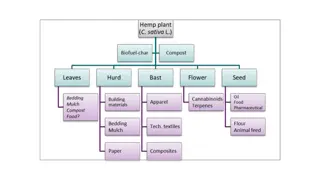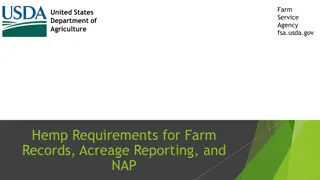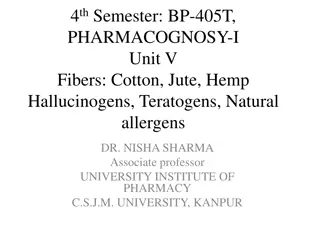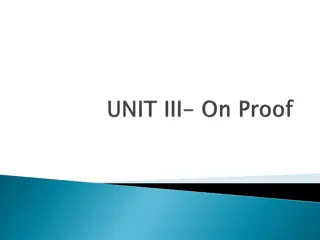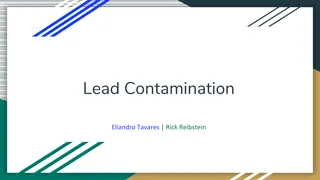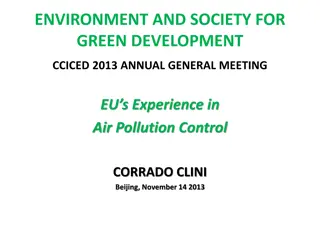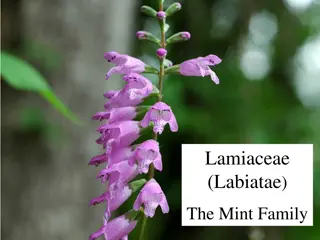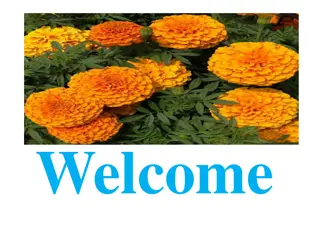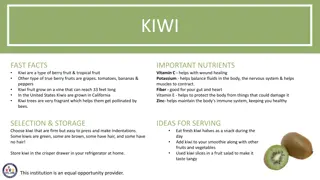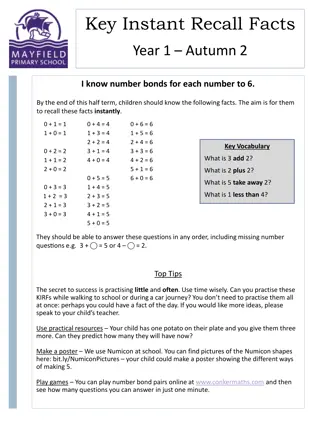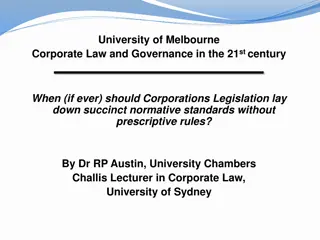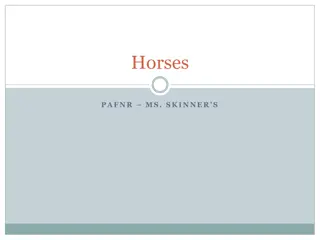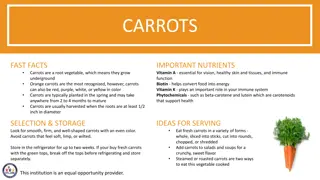Exploring the World of Hemp: History, Facts, and Legislation
Unearth fascinating insights into the historical significance of hemp, from its prevalence in paper and rope production to its potential as a sustainable energy source. Discover the key points from the 2018 Farm Bill and WA Hemp Bill 2019, shedding light on the evolving regulatory landscape surrounding hemp cultivation. Delve into the genetics of hemp, exploring the implications of open-source cultivation versus material transfer agreements for genetic diversity and development.
Download Presentation

Please find below an Image/Link to download the presentation.
The content on the website is provided AS IS for your information and personal use only. It may not be sold, licensed, or shared on other websites without obtaining consent from the author. Download presentation by click this link. If you encounter any issues during the download, it is possible that the publisher has removed the file from their server.
E N D
Presentation Transcript
Washington Grown Hemp Basics Industrial Hemp Association of WA
Hemp History and Facts Until 1883, 75-90% of all paper in the U.S. was made with hemp Hemp seed was the #1 selling bird feed; 4 mil pounds were sold in the U.S. in 1937 Until 1937, 70-90% of all rope and twine was made with hemp In 1850, the U.S. Census reported 8,327 hemp plantations of at least 2,000 acres in size (not counting that there were thousands of smaller crops!) It is estimated that if 6% of the continental U.S. were planted with hemp, it would provide for all national energy needs The University of Missouri estimates that an average size metro area production of 100 million gallons of biodiesel fuel could generate $8.34 mil in personal income and 6,000 temporary and permanent jobs (Ref: Nat l Biodiesel board) Hemp paper can be recycled up to 7 times; wood pulp paper only 4 Hemp fuels do not destroy the ozone layer or contribute to global warming Hemp fuel is 10 times less toxic than salt and as biodegradable as sugar
2018 Farm Bill The Farm Bill authorizes CBD only to the extent that it is contained in hemp produced in a manner consistent with the Farm Bill and other federal and state regulations The Farm Bill allows states to become the primary regulators of hemp cultivation while enabling researchers to apply for federal grants and making the crop eligible for federal crop insurance
WA Hemp Bill 2019 Estabilishes a Hemp Agricultural Commodity Program to replace the IHRP Eliminates the 4 mile buffer zone between Hemp and i502 Marijuana grows Allows non certified seeds to come from with-in the country without a DEA permit. Documentation of seed varieties is submitted to the WSDA. New THC testing protocol to start in 2020 with a Delta 9, Post Harvest, Whole Plant Ground Sample without heat applied 2019 THC testing will be Total THC, Pre Harvest, Whole Plant Ground Sample without heat applied A license is required to grow hemp with GPS field coordinates on file, THC testing by the WSDA and 10 years with no felony drug charges.
Genetics Genetics are the foundation! Open source vs. MTA Open source o Anyone may freely use this is, grow, propagate, develop it further and use it or breeding; they may be sold, exchanged or given away o Each recipient assign the same rights and obligations to prospective users (breeders/growers) of the cultivar and its further developments MTA o A Material transfer agreement is a contract that governs the transfer of tangible biological materials (seeds, clones, seedlings) between two individuals, when the recipient intends to use it for his/her own production purposes. The MTA defines the right of the provider and the recipient with respect to the materials and any derivatives. If you change the genetics, you own and can do what you want
Genetics Monoecious plants have both male and female flowers on the SAME specimen This means that while a monoecious plant may pollinate itself, dioecious plants require a partner to achieve pollination Dioecious plants product male and female flowers on DIFFERENT specimens Most industrial hemp varieties are dioecious where the male and female plants are separate in an approximate 50:50 ratio The male plants flower and pollinate the female plants then after, die off and the female plant continues to grow and set seed The THC/THCA level may vary with stage of growth, nitrogen intake and may increase under environmental stress conditions (like stress free existence) Canadian and European cultivars are commonly suitable for both grain and fiber production and mature to fiber in 60-90 days; grain in 110-150 days Auto-flowering vs. Traditional varietals Traditional varietals will need 12+ hours off darkness a day to initiate flowering whereas auto varietals do not need any special kind of light schedule to tell the plant to start budding; each auto flowering plant start blooming after a few weeks no matter what light schedule is provided therefore, there s no need to match up the strain with your local time zone or plant at the perfect time
Genetics Females can (and will) product male flowers whenever they are severely stressed You can check and identify males and hermies using a 6 inch (min.) magnifying glass and looking for the curve at the end of the male pre-flowers.
Life Cycle Emergence (0 to 4-9 days) is the most critical phase and days will depend on soil conditions, temperature and light Establishment (4-9 days to 3 weeks) is the slow growth stage off the crop during which the canopy is established. Once complete canopy happens, the crop will measure 25-30 cm in height and each plant will have 3 leaves Active Growth (3 weeks to 2.5 months) is the period between establishment and initiation of flowering and when fiber production takes place. Mineral and water demand is the greatest and when the plant is most sensitive to lodging (the displacement of stems or roots from their vertical and proper placement) Flowering is the appearance of the first flowers and is related to the total temperature during emergence and to the photosensitivity off the variety. Growth slows during this period. Full Flowering is the stage when the opening of the last female flowers happens and is strictly dependent on the photo period. A particular variety grown in a particular zone will reach this point at a specific date, irrespective of the date of the sowing or of any variation in annual condition End of Flowering is when the last flowers are pollinated. This point marks the end of the growth and determines the final yield of fiber; it initiates the maturation of the fiber and seeds. Seed Maturity is obtained 40 days after full flowering.
Soil Soil Texture testing Once prior to final field section (avoid sloping, low drainage spots) The ideal soil texture will range from 5-30% clay, 20-70% Silt, 20-70% sand for a medium loam Hemp responds to a well drained, loam soil with pH (acidity) about 6.0. Neutral to light alkaline (pH 7.0 7.5) is preferred; Clay soils can become compacted and hemp is very sensitive to soil compaction The higher the clay content of the soil, the lower the yield of fiber or grain produced Poorly structured, drought-prone sandy soils provide very little natural fertility or support the plant therefore, extra nutrients and water are required to achieve maximum yield on these soils Organic Matter Matters! Higher CO2 levels in the soil are a function of natural OM decomposition Ideal soil CO2 saturation levels range from 1200 1500 ppm Reasonable soil analysis 1.5% through 4% (Taos maybe 3-6% if not eroded) A crop can still be organic if at lease 3 years have lapsed since the last contaminate or pesticide has been applied
Soil Feed the soil; then let the soil feed plant Base Saturation is a numerical description (%) of how many of which assorted cations are attracted to the frayed edges and plays a large role in the natural fertility of the soil. Ideal numbers are: Calcium (Ca) 60-80% Magnesium (Mg) 10-15% Potassium (K) 4-7% Hydrogen (H) affects soil acidity and in climates with 20 inches off rain per year, Sodium (NA) is also important. When H is present (acid soils); Ca, Mg and K can be increase with corrective fertilization however, it is extremely difficult to decrease the saturation of a cation expect by raising the CEC with more OM. Increasing both pH and OM provides multiple benefits because saturation moves upward, moisture retention improves, and CEC rises. OM contribution to CEC is pH dependent, and is multiplied as soil becomes neutral to slightly alkaline.
Soil Fertility Balanced pH and Base Saturation Industrial hemp responds best to a loam soil with pH (acidity) above 6.0 however, neutral to slightly alkaline (pH 7.0 7.5) is preferred and you don t want it to be over 8 pH The soil sample and techniques constitutes the largest single source of error in a soil testing program. A poor sample is not only a waste of time and money but also leads to erroneous conclusions and recommendations which will prove costly to the cultivator. Soil sampling is the most important step in good soil testing program. The chemical analysis of the sample will measure the nutrient status of the soil and serve as a guide to profitable use of fertilizer. Soil test results can be no better than the sample collected to represent the field. Collection of representative soil sample is the most important step in soil testing program and fertility management program. Proper sampling tools are essential for collection of good soil sample. For a soft moist soil, the soil probe usually quite satisfactory. For dry and hard soils screw type probe are very useful. Soil Sample Technique What you ll need: Soil Probe (or garden spade will suffice) Bucket (mixing multiple sample plugs together) A spatula (wooden stick) for mixing samples One quart plastic baggie with zip closure Label for field number/name Note: If lab requires a Soil Analysis Request Form, request directly from the lab prior to process.
Nutrient Deficiencies Nutrients Symptoms Zinc Sulphur The topmost leaves turn yellow. Lower leaves turn yellow. Yellow starts at the base of the leaf and proceeds to the tip. Brown or yellow edges on all leaves regardless of their age. Potassium Phosphorus Brown spots all over the leaves. Affected leaves will die and drop off. Red/Purple over the entire leaf. Manganese Shows up on older plants. Also shows yellow between the veins of the leaf. Iron The topmost inner leaves turn bright yellow or even white. Copper Leaf tips appear yellow. The leaves are dark green. (Could confuse with Potash). Brown spots that eat right through the leaf. Stems may be hollow and brittle. Calcium Boron New foliage growth is very thick. Brown spots on the underside of the leaf. (Growing point are yellow and pink) pH of 7 will have Manganese problem; not much you can do if an alkaline soil Iron is not very mobile so should be able to spray/treat leaves if an issue
Pure Live Seed (for planting) Poor germination equates to poor establishment. Poor establishment leads to increased weed pressure, reduced yields, harvesting problems, or crop failures. Using the proper seeding rates based on PLS is imperative for successful hemp establishment and harvest. Note that the seed weights vary significantly among hemp varieties. The seed weights can sometimes differ by two times among varieties, which would have a highly significant impact on plant populations and successful establishment.
Hemp seed labels Name or kind of seed present Variety name or the letters VNS (variety not stated) Lot number Origin (State or Country) Percentage by weight of all weed seeds (by law, this should be included) The name and rate if occurrence of all noxious weed seeds. Percentage by weight of inert matter Percentage of germination, exclusive of hard or dormant seed, if present. The calendar month and year that the test was competed to determine germination percentages. Pay attention to the germination percentages listed on the label. By law, the crop planted should actually germinate at the level listed on the label. Pay attention to the seed test date (calendar month and year that the test was completed). The test data determined during a test is only valid for 13 months. Seed is alive and it will decline in germination percentage over time, just as other commodities that have a shelf life decline. Inquire about how the germination tests are performed. By law the term certified seed means; seed certified by a seed certifying agency. Storage can last 2-3 years
Seeding Basics and Establishment Hemp seed is quite sensitive to insufficient soil moisture at planting, a trait which may contribute to weak stands and potential crop failure. Crops should be sown into moist soil after a good rain, rather than before, to avoid soil crusting or wash- out(s). Soil moisture that is inadequate for fast hemp germination will still have adequate moisture to support germination for many species of weeds. Industrial hemp seed can be successfully planted with a precision planter specifically configured for that purpose. Use of other planter systems are optional with significant possibly of reduced seeding success. Seed soil contact is critical for good germination. Seeding dates will depend equally on the harvestable component (fiber, grain, or cannabinoids) and the variety. Planting depth should not exceed 1 inch; inch is ideal. Planting deeper makes plant more susceptible to damping off (pre-emergent or post emergent). In warm soil, hemp will germinate in about a week, and should be seeded at about the average date of the last spring frost, or perhaps a week earlier. It will normally be about 12 inches tall a month after planting. Without the availability of labeled herbicides for industrial hemp production systems, we rely heavily on rapid hemp canopy development and closure to reduce or eliminate competition from weeds. Row spacing will vary based on the harvestable component and the variety. Between row spacing of 15 or 30 inches are ideal for weed control and timely fertilizer applications. Tilling about 1 month prior to planting will help reduce weed pressure
Seeding Establishment Plants need 100 days of warm weather Fiber can be planted much more closely Tall plants don t mean more seed/grain yield The yields that industrial hemp will produce depends on the land it is planted on, the growing conditions, and the farming techniques used. CBD/Cannabinod Flower Vrieties Photo Period 2000 seeds/starts/clones @ 4-6 foot spacing Auto Flower 5000-15000 seeds/starts/clones @ 3-4 foot spacing Fiber 30lbs per acre Grain 28lbs per acre
Planting Hemp Plastic mulch raised bed layers with drip applicators Mounded rows with drip applicators Flat land with drip applicators To Till or Not to Till Water Wheel or hand planting for starts/plugs/clones Seed Planters with variable distances or plugged sections Hand planting seeds @ 1 inch
Water Management Industrial Hemp will be most productive in climates with at least 20-30 inches annual rainfall. Water application varies greatly based on climate, soil texture, slope, and growing production methods. Modest moisture is required during the emergence and establishment growth phases. During the vegetative growth phase, hemp responds to higher daytime temperatures with increased growth. Water demand peaks. Water demand begins to decrease during the flowering growth phase. Industrial hemp uses half the water of wheat and less than corn and soybeans. Examples of water management systems include: Drip line systems, sprinkler systems, pivot irrigation, and flood irrigation.
Pests and Disease Adopt an Organic Farmer(s) approach and process for pest and disease control. Plant positive rather than pest negative. As growers we have become used to direct responses to pest pressure; with Industrial Hemp this is not possible and we must adopt indirect methods and processes to overcome these challenges. Weeds Insects: aphid, hemp russet mite, stink bugs, grasshoppers, two spotted spider mites. Diseases: Powdery Mildew, Xanthomonas leaf spot, Xanthomonas campestris pv. Cannabis, Fusarium wilt, Hemp Canker Nematodes: Columbia root knot nematode, stem and bulb nematode Viruses: Alfalfa mosaic, Cucumber mosaic, Hemp mosaic, Hemp Streak Example - One of the primary diseases is white mold (Sclerotinia). A fungus which prefers cool, dark, moist conditions. This points the way to natural control; in this case row spacing and orientation is effective because better ventilation and more evenly distributed natural sunlight is provided. This is considered indirect control. Mites are cousins to ticks and spiders. They are most troublesome in hot-dry weather and climates. Mites feed on the under-sides of leaves, which when attacked will first stipple on top, eventually looking yellow on top and scorched on the bottom. Regardless of climate, mite pressure worsens under drought stress. Across the central US there are three major pest mite species affecting hemp: red mites (reddish orange) are more prevalent in moderately humid climates than in really dry ones; the Banks grass mite prefers truly dry climates; and the two-spotted mite is common all across the region.
Harvesting of Hemp Harvesting by Hand 1-5 acres Harvesting equipment has not caught up to the market Hemp is a resin plant that sticks to metal Hemp is strong and binds up machinery wraping around moving parts
Drying of Hemp Drying is the crucial point to get hemp to market. Proper drying to control moisture and mold CBD-Hang Drying the whole plant for flower and bio-mass Extremely low heat long drying process with moisture control Fiber retting for dried stalk
Crop Rotation A four year crop rotation is recommended. As a rule, do not grow industrial hemp on the same fields following edible beans, soybeans or sunflowers where Sclerotinia is a major disease concern. Crop rotation is an essential management approach to reduce disease pressure
Innovation S-Curve 6-7 year/phase 40-50 years total DH Die Hards (1%) Are you kidding me? LG Laggards (1-10%) Why should I? LM Late Majority (50-90%) How much does it cost? Where $ Where $ is made! is made! EM Early Majority (10- 50%) Why this one? EA Early Adopters (1- 10%) Where can I get it? IN Innovation (0-1%) What is this?
